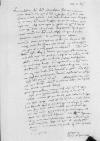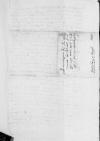Letter #667
Sigmund von HERBERSTEIN to Ioannes DANTISCUSKlamm, 1531-08-10
| received Brussels, [1531]-08-31 Manuscript sources:
Auxiliary sources:
Prints:
| ||||||||||||
Text & apparatus & commentary Plain text Text & commentary Text & apparatus Excerpts concerning Dantiscus' travels
Reverendissimo domino, domino
Reverendissime Domine, Domine observandissime. Post mei et servitiorum meorum commendationem.
Vestrae Reverendissimae Dominationis cf.
Ex
Eiusdem Vestrae Reverendissimae Dominationis deditissimus
[1 ] After completing his mission to Hungary with the aim of achieving a truce in Visegrád, on May 25 Herberstein was urgently sent to Poland, chiefly in connection with Hungarian affairs (safeguarding the truce by having Sigismund I and Saxon duke Georg sequester castles belonging to Ferdinand I and Zápolya). He set off from Vienna to Cracow on June 6, arrived on June 14, to leave on July 7 (
cf. HERBERSTEIN 1855 p. 294-295 ⌊Herberstein 1855, p. 294-295cf. HERBERSTEIN 1855 p. 294-295 ⌋, cf.
cf. EFE 46 No. 54, p. 74 ⌊Elementa, XLVI, No. 54, p. 74cf. EFE 46 No. 54, p. 74 ⌋;
cf. AT 13 No. 95, 96, p. 94, No. 199, p. 195-196, No. 218, p. 209, No. 221, p. 211 ⌊AT, XIII, No. 95, 96, p. 94, No. 199, p. 195-196, No. 218, p. 209, No. 221, p. 211cf. AT 13 No. 95, 96, p. 94, No. 199, p. 195-196, No. 218, p. 209, No. 221, p. 211 ⌋;
cf. POCIECHA 4 p. 117-121 ⌊Pociecha IV, p. 117-121cf. POCIECHA 4 p. 117-121 ⌋
, see also cf.
[2 ] This fascicule probably contained Dantiscus’ letter to Sigismund I (see cf. AT 13 No. 194, p.188-9 ⌊AT, XIII, No. 194, p.188-9cf. AT 13 No. 194, p.188-9 ⌋) and Dantiscus’ unknown letter to queen Bona, mentioned below (see footnote 9)
[3 ] Unknown letter. Its content can be guessed from queen Bona’s reply to Dantiscus dated on the day Herberstein left Cracow – July 7 ( cf. AT 13 No. 221, p. 211 ⌊AT, XIII, No. 221, p. 211cf. AT 13 No. 221, p. 211 ⌋), from Lodovico Alifio’s letter to Dantiscus (see footnote 11), and from the present letter
[4 ] cf.
[5 ] The day Herberstein left Cracow – July 7, 1531 – is the date of Queen Bona’s letter to Ferdinand I with assurances of her friendship and confirming her authorization for Herberstein to report on matters he has been entrusted with orally (see cf. AT 13 No. 218, p. 209 ⌊AT, XIII, No. 218, p. 209cf. AT 13 No. 218, p. 209 ⌋, cf. cf. AT 13 No. 270, p. 251 ⌊No. 270, p. 251cf. AT 13 No. 270, p. 251 ⌋; cf. POCIECHA 4 p. 119-121 ⌊Pociecha IV, p. 119-121cf. POCIECHA 4 p. 119-121 ⌋)
[6 ] Hieronim Łaski in spring 1531 he went on a mission to Suleiman I to obtain his consent to a year-long truce for Hungary (see cf.
[7 ] After leaving Cracow (see footnote 4), on July 24 Herberstein and Hieronim Łaski reached České Budějovice (Budweiss) where Ferdinand I was staying ( cf. HERBERSTEIN 1855 p. 295 ⌊Herberstein 1855, p. 295cf. HERBERSTEIN 1855 p. 295 ⌋; cf. cf. HERBERSTEIN 1560 f. D2v ⌊Herberstein 1560, f. D2vcf. HERBERSTEIN 1560 f. D2v ⌋)
[8 ] Herberstein is probably referring to Giannantonio Donato, duke d’Atri, count of Conversano and San Flaviano (d. 1554). We know Dantiscus corresponded with his father, condottiere Andrea Matteo III Acquaviva d’Aragona, duke d’Atri (1457-1529), a close neighbor and friend of Duchess Isabella d’Aragona, mother of queen Bona Sforza
[9 ] Cf. cf. AT 13 No. 309, p. 291 ⌊AT, XIII, No. 309, p. 291cf. AT 13 No. 309, p. 291 ⌋. The unofficial objective of Hieronim Łaski’s stay at Ferdinand I’s court was to discuss the terms of entering the service of the Habsburgs (see cf. POCIECHA 4 p. 122-123 ⌊Pociecha IV, p. 122-123cf. POCIECHA 4 p. 122-123 ⌋)
[10 ] After leaving České Budějovice (Budweiss), Herberstein and Hieronim Łaski traveled via Krems an der Donau to Vienna, from where Łaski set sail along the Danube to Buda on August 5, while Herberstein went to his Klamm Castle near Schottwien am Semmering (see
cf. HERBERSTEIN 1855 p. 295 ⌊Herberstein 1855, p. 295cf. HERBERSTEIN 1855 p. 295 ⌋, cf. cf.
[11 ] Together with Hungarian chancellor István Brodarics, designated by King János I Zápolya, and with delegates of the Polish king, Hieronim Łaski was supposed to go on a great mission to the emperor, the pope and the kings of France and England to discuss the peace in Hungary. Ultimately, in early October Łaski set off for the Reich diet called by Emperor Charles V in Speyer. The diet did not gather then, but was called again for early 1532 inRegensburg (began in April). Meanwhile, Herberstein’s reports made Ferdinand I change his stance on resolving the Hungarian conflict with Polish mediation and Łaski’s negotiations at the end of 1531 failed (see cf. AT 13 No. 286, p. 263-264; No. 309, p. 291-292 ⌊AT, XIII, No. 286, p. 263-264; No. 309, p. 291-292cf. AT 13 No. 286, p. 263-264; No. 309, p. 291-292 ⌋; cf. AT 13 No. 83, p. 141-142 ⌊AT, XIV, No. 83, p. 141-142cf. AT 13 No. 83, p. 141-142 ⌋; cf. EFE 35 No. 282, p. 42-43 ⌊Elementa, XXXV, No. 282, p. 42-43cf. EFE 35 No. 282, p. 42-43 ⌋; cf. DEGGELLER p. 42 ⌊Deggeller, p. 42cf. DEGGELLER p. 42 ⌋; cf. POCIECHA 4 p. 122-128 ⌊Pociecha IV, p. 122-128cf. POCIECHA 4 p. 122-128 ⌋)
[12 ] János I Zápolya (1487-1540), voivode of Transylvania (1511), a representative of Hungarian magnates related to the Jagiellons (his sister Barbara was the first wife of King Sigismund I); in November 1526 he was proclaimed the “national” king of Hungary by a part of the Hungarian nobility (against Ferdinand I) and crowned, which led to a division of the Kingdom of Hungary that had far-reaching consequences. In 1539 he married Isabella – daughter of King Sigismund I and Bona Sforza
[13 ] A reference to Dantiscus’ request, put forward with increasing forcefulness at least from 1528, to relieve him of his long-lasting diplomatic service at the court of Charles V, which had lasted uninterruptedly since his departure from Cracow in March 1524. Dantiscus was formally recalled to Poland in February 1532 (see cf.
[14 ] Most likely a reference to matters of the Italian duchies of Queen Bona: the duchies of Bari and Rossano. In 1524, after the death of Isabella d’Aragona – Queen Bona’s mother – envoys Lodovico Alifio (see footnote 10) and Dantiscus were entrusted with taking over this inheritance. Dantiscus, as a resident representative of the king and queen of Poland at the imperial court in 1524-1532, dealt with all matters related to Queen Bona and Sigismund I entering into possession of the Italian duchies, to administration of the duchies and to the income derived from them (see
cf. POCIECHA 4 p. 211-296 ⌊Pociecha IV, p. 211-296cf. POCIECHA 4 p. 211-296 ⌋; cf. letter cf.
[15 ] A reference to the merely opportunistic change of attitude towards Ferdinand I after the hostile mood that Herberstein had commented on in 1529 (see cf.
[16 ] Another reference to matters of the duchies of Bari and Rossano. Most likely Ferdinand I’s vague reply to the queen Bona’s letter of July 7, 1531 includes a promise to support these very issues (see footnote 13; cf. AT 13 No. 270, p. 251 ⌊AT, XIII, No. 270, p. 251cf. AT 13 No. 270, p. 251 ⌋, cf. cf. POCIECHA 4 p. 121 ⌊Pociecha IV, p. 121cf. POCIECHA 4 p. 121 ⌋)

